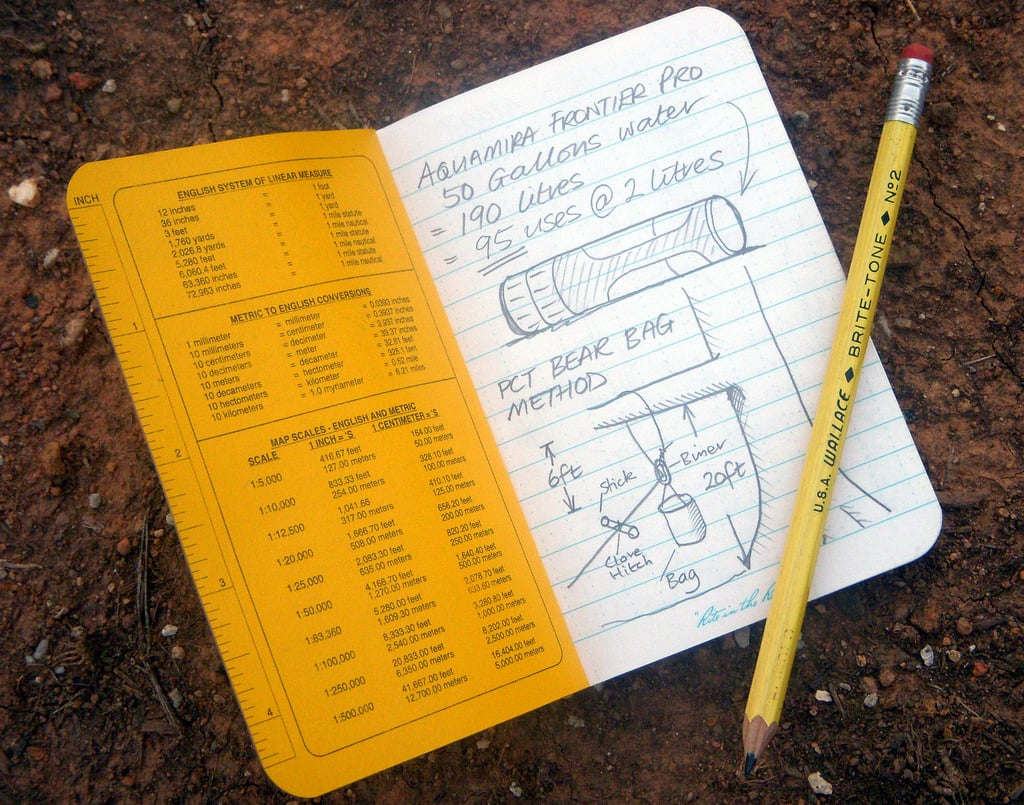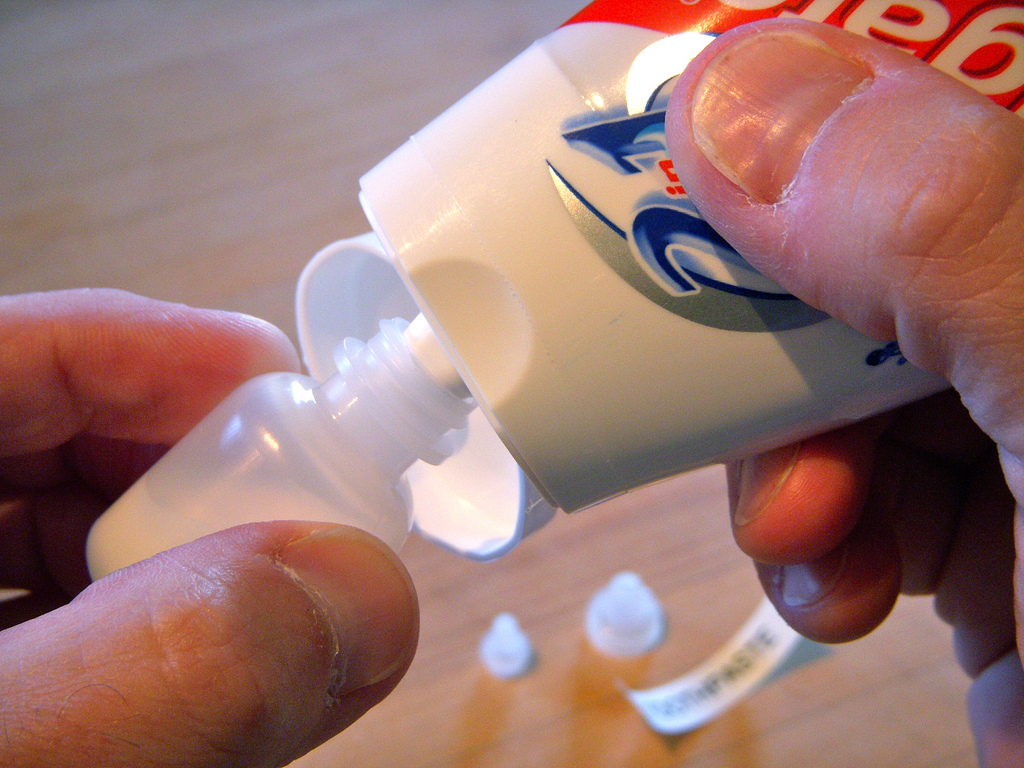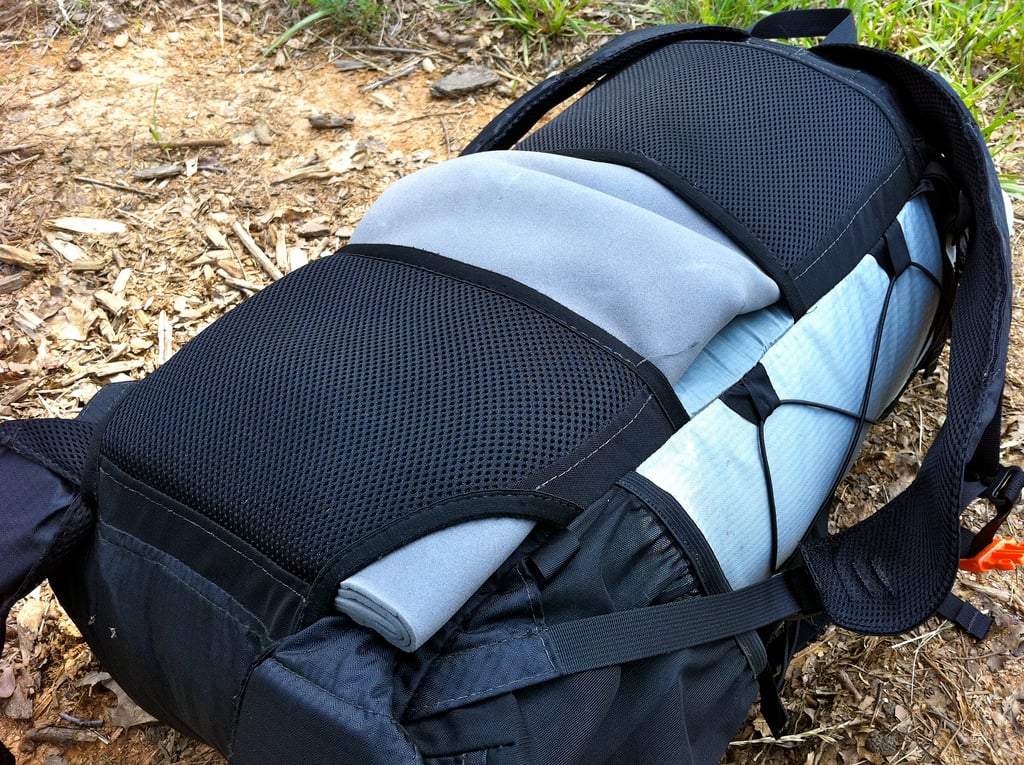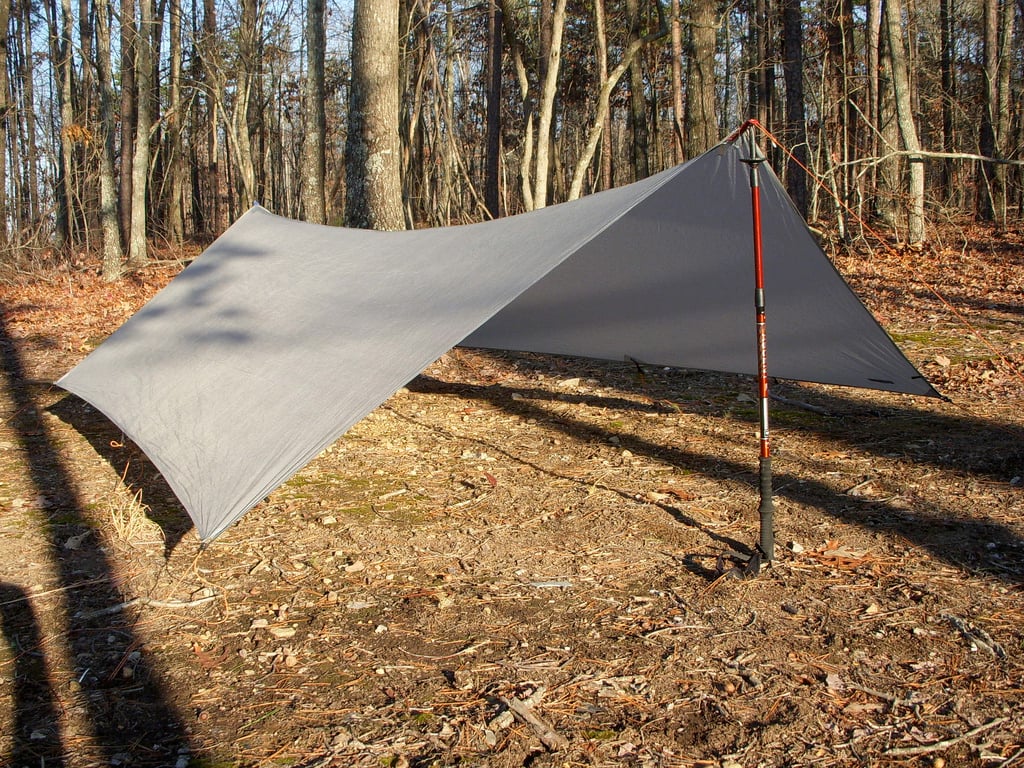On May 7th, I completed the GORUCK Challenge (class 031) in Rehoboth Beach, Delaware and will be forever changed. If you aren’t familiar with the Challenge, it’s billed as a team event that lasts 15-20 miles and around 8-10 hours. Although, the cadre loves to under promise and over deliver.
Straight from their site, here is the Challenge in a nutshell:
You and your fellow Challenge takers all wear GORUCK backpacks throughout the Challenge. Yes, your bags will be weighted down with bricks, but if the Challenge were easy you wouldn’t sign up. In fact, the greatest hurdle is signing up. We are proud that the pass rate is over 98%.
You won’t know the route but it showcases the best of every city. Think of it as a guided tour. The miles don’t disappear on their own, and 8 to 10 hours can feel like a lifetime. Welcome to our version of good livin’.
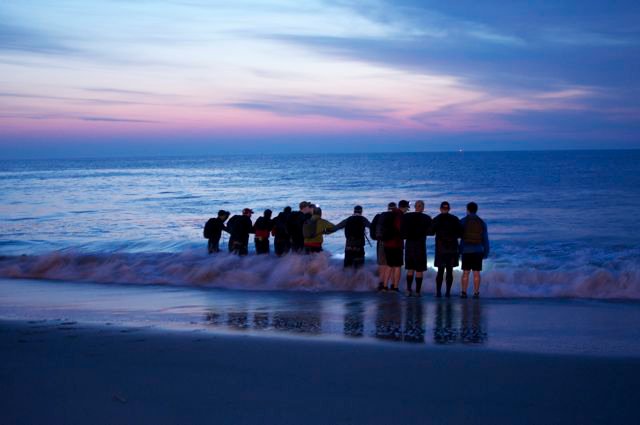
Why did you decide to do the GORUCK Challenge?
I’ve always wanted to be tested and see what I am made of. To test the strength of my steel. To truly look hardship and difficulty in the eye and face it. The GORUCK Challenge seemed to be exactly just that test. Not many people take the hard way anymore and I decided to pursue it.
When I brought up the Challenge idea to others, a few people had ‘that’ look on their face. Almost as if they wanted to say it was impossible but they didn’t want to seem rude. One guy even flat out told me that I couldn’t do it. What makes them think that? I intended to prove them wrong. It’s hard but I try to give no energy to the critics.
The other reason I signed up is because the Challenge wouldn’t be back in my general area for months. I wanted to get in while it was still within driving distance and the Challenge was still relatively unknown.
How did you prepare for the GORUCK Challenge?
I started off by doing some simple Google searches and reading about the experiences of past Challengers. I also chatted back and forth on Twitter with a couple of guys who signed up for the Challenge as well. Eventually I learned that my type of training should match the Challenge; unconventional.
I decided to break down each element of the Challenge and tried to figure out exactly what would be required of me. Nowhere is it listed what elements the Challenge will enlist so I had to rely on they’ve done in the past. This is the basic list:
- 15-20 mile run
- Log carry
- Buddy carry
- Pushups
- Flutter kicks
- All of these done with at least a 20 pound ruck.
The moment I heard about the Challenge, I wanted to see how feasible it was for me. I’ve never run with any serious amount of weight on my back before so I went outside, found a rock I thought was 20 pounds and ran with it. When I got home and weighed the rock, I realized I made a gross miscalculation. Turns out my rock was 40 pounds exactly.
I kept the rock and even ran with it one more time (a 4 miler) but I put it on the back burner because I didn’t plan on doing the Challenge for some time. I decided to wait until I was ready (which usually means it’s not going to happen).
When my birthday rolled around, my wife surprised me by teaming up with my in laws and getting me a GR1. When I picked up the ruck from Polly & Sophie at their DC office, I started to think more seriously about the challenge. They asked if I was going to do one and I just replied that I would like to but I don’t feel ready at the moment. They said I really should just do it. That’s when I started prepping with the GR1.
Building up courage and deciding to jump in with both feet, I signed up for the Challenge. I had 17 days. The weekend before I made the decision to officially sign up, I thought I’d go for a long run under load. In addition to a 25 lb dumbbell, my ruck with water, a jacket, multi-tool (basically a ton of EDC stuff) weighed in at 35 lbs. I did just under 10 miles nonstop and felt pretty good.
In a way, I’ve been gently prepping myself for this Challenge for months. Living in Northern Virginia and working in DC means I have a decently long public transit commute. I bring everything I might need throughout the day in my backpack including that days lunch and water etc. I was curious as to what my ‘daily ruck’ weight was because it doesn’t feel very heavy at all so I hopped on the scale and it came in just shy of an even 20 lbs. Not too bad! While it’s only weight I’ve carried while walking, it’s still weight that my body & back should have built up some tolerance against.
Over Analyzing vs Preparation; A Fine Line
I like to be prepared in everything I do. Some may see it as over analyzing and I understand that. But I just want to be as ready as possible so I’ll be able to focus on the experience.
What did I do to improve my odds? Well, I focused on getting gear that would make it easier for my body to do the real work. No amount of high end gear will get you through this Challenge, always remember that. It’s also worth noting that while I tried to find gear I thought would be perfect, there’s no real ‘right’ solution. What worked for me may not work for you and even more importantly, this is not a recipe that will guarantee you success.
I had to keep things on a strict budget so while I’m sure there are better options, I decided to go with a judicious mix of quality vs cost.
Carrying a loaded ruck while literally hitting pavement has got to have some sort impact on your feet. So I went looking for a cushioned trail running shoe. I have a very worn pair of Salomons I wanted to use but they are just too thrashed; the soles are slick with no more tread and the heels are tearing which gives cuts and blisters. With the amount of running I was going to be up against I knew I should spend the cash on some new shoes just for the Challenge.
I went to my local City Sports and tried on a few pairs. I was looking for a blend of features (trail grip, cushion, weight) and price. While I couldn’t really afford to get new shoes for the Challenge but I decided it was a necessary purchase; something that I would be extremely thankful for later. Luckily they were lower end and I had some ‘City Sports cash’ to redeem.
I worked hard on breaking in the new shoes and they seemed to be working very well. I ran in and through mud and up to my knees in the river to see how they took took on and shed water and just handle a mixture of elements. I’m happy with them.
A Looming Deadline
My day is getting closer. As I check the Events tab on the GORUCK Facebook Page, I get a feeling in my stomach of anxiousness. My class is at the top of the list, next in line for evaluation. 5 days away. Gosh that seems sudden.
It doesn’t matter. I don’t need to feel worried or anxious. Why? Because I know I’m going to finish and complete the Challenge. I want the GORUCK Tough patch. How does one get it? By completing the GORUCK Challenge. So it’s pretty simple really. I know what I have to do.
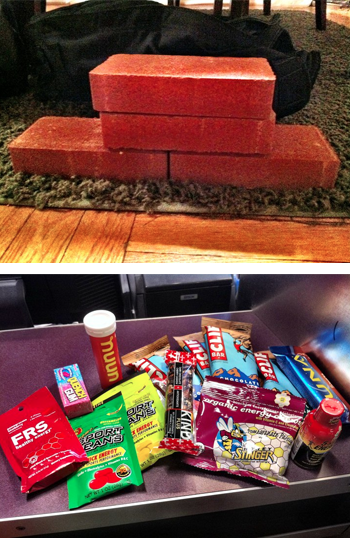
Countdown: 3 Days
I still haven’t bought my bricks and it’s Wednesday. I think I’ll go tonight though.
I also need to get my fuel, which will most likely be in the form of candy and energy bars/GU/beans/gum/etc. I’m planning on raiding City Sports tomorrow and getting a bunch of different stuff to offer some variety.
I have no idea what I’ll be hungry for, or what I can even stomach so I need to get it all. I’d rather carry the extra weight than drop out of the Challenge due to lack of energy.
Packing
As I wrapped the bricks with duct tape, I felt an odd sense of calm. I was expecting to get more anxious at that point. After a good bit of duct tape, a t-shirt, and part of a contractors bag (for waterproofness), the bricks weighed in at 17 pounds exactly. Now my scale isn’t the most accurate but it made me feel really good because I’ve been running with a 25 pound dumbbell.
Packed everything for the weekend and checked it three or four times, not wanting to leave anything behind. I’m pretty sure that I have everything I need, for the most part anyway. It’s hard to really have everything. I also am trying to keep things as light as possible.
Countdown: 6 Hours
Almost on my way to the in-laws (drop the wife off) then onto Rehoboth Beach and my mind is wandering. It’s good stuff though. I mean, if I’m not careful, my mind tries to sneak in the thoughts of pain and cold and hunger but I quickly look at it differently. ‘It’s only a few hours! Not even a full day! How many times have my friends and coworkers (and myself) gone through an entire weekend having done absolutely nothing!?’
I could be sitting on my butt all weekend, sleeping in and watching movies. But I chose to do this Challenge. Once I start, there is only short amount of time that ‘uncomfortableness’ has to endure. After that, it’s back to relaxing with friends and family. Sitting on the porch or hammock, enjoying the breeze like a sane human being (yeah, I think there is a certain level of ‘good’ crazy needed for the GORUCK Challenge). How many people choose to remain comfortable?
What is your biggest fear/demon for the Challenge?
If I were forced to pick something, I would say that I’m worried there is too big a difference in the physical abilities of myself and the others. From the photos and videos I’ve seen of past Challenges, the dudes (and ladies) looked extremely well built. Some were full on race horses without an ounce of unnecessary fat. Well that’s not me. I mean, I’ve been steadily losing weight, gaining strength, and intensifying my running speed and distance but I still feel like an average soggy 20 something.
What do you feel is your biggest strength for the Challenge?
My heart. My mind is weak and my body is weaker but my heart is strong. My heart will command my body to do the things my mind says are impossible. While my mind may be going through a constant battle, in my heart, I know this battle is won.
On the physical side, I feel I have a very solid running foundation. I’ve been known to run for miles with no goal in mind and no hint of stopping. I can become an unstoppable train and while I may not always get there first, I get there. I also am used to carrying 20 pounds on a daily basis and have done some significant runs with weight up to 35 and 40 pounds. I think the sheer miles mess with most Challengers but I’m actually excited to see how I perform.
Does anything about the Rehoboth Beach Challenge specifically make you excited or nervous?
The soft sand running is going to be tough and slow. A real suck. I know we are going to spend time in the ocean and the ocean in the black of night can be a bit of a demon. I grew up in Delaware and have been to the Rehoboth Beach a number of times but I’m mostly excited about seeing it in a completely different light than I ever imagined. Also, watching the sun rise on the beach is always fun.

The Evolution
Note: While I’m including a lot of different elements in this write up, there are also some things I didn’t include because you just have to experience it yourself.
1AM start.
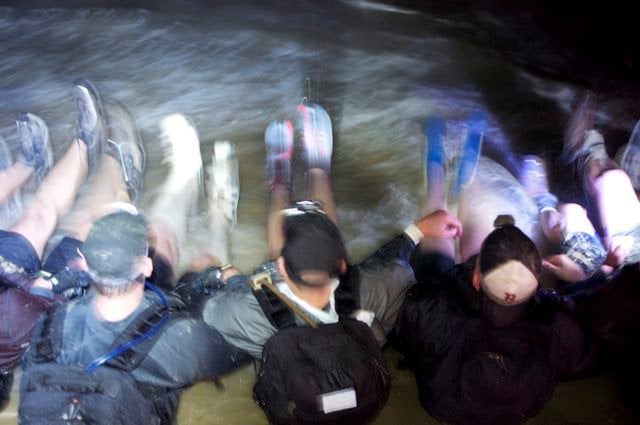
Within the first few minutes, we hit the surf and were on our backs doing flutter kicks. We had to lock arms to keep the waves that were crashing over our heads from pulling us into the dark and chilly waters. Sand instantly penetrated every crevice it could find. After doing enough flutter kicks (which looked a bit more like synchronized swimming), we were up and back in formation running down the beach.
While attempting to find a better system for our Indian sprints and taking too long, we were ordered back in the surf. Pushup position.
Jason decided we weren’t ready to run so we did bear crawls. The sand just barely giving any support to our outstretched arms and legs, it was slow going for what seemed like miles.
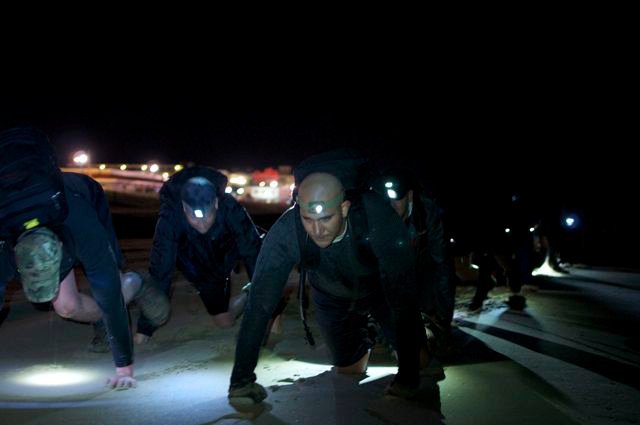
“Why are we doing bear crawls when we’re at the beach?” Good point actually, so we were ordered into the crab-walk position but the rucks were not allowed to touch the ground. After a good distance of crab-walks, we were up doing lunges.
Eventually we graduated to trying running again. We developed decent system down and proceeded to do our Indian sprints and soon hit solid ground. Just as we left the beach, we found our first coupon (redeemable for extra “good living”). A beach chair. Fitting.
Everyone was still all smiles and having a good ol’ time so Jason bounded ahead while we continued our two column formation. We soon caught up to Jason who found us our second coupon, a well worn and stained box spring.
More Indian sprints up the boardwalk, fist pumping our coupons, we circled around back to the main drag and stopped for a snack & pee break. You can’t be a team when one of you goes around the corner to pee (who knew!?) so we were immediately put in the pushup position. This is something Jason doesn’t take pleasure in. It was stupid that we had to do pushups, no need. We had a long way to go before we truly became a team. So when one peed, we all peed. Together.
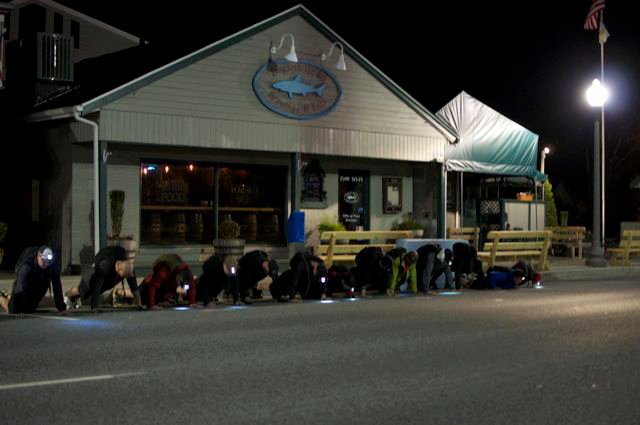
Then came the buddy carries. We were instructed to get two men up in a fireman carry. While taking too long to figure it out, the order for three men up came. No more foolin’ around. We got em up and started the long march down the street. It didn’t stop until we got the word so we took very quick breaks just long enough to switch partners when necessary. Eventually we set our man down and continued fist pumping our coupons down the boardwalk.
This was all before sunrise.
When the boardwalk ran out, we transitioned to soft sand. Sometimes we were lucky and steered towards some harder pack sand for a bit. What a treat.
Jason broke off from our group and ran away from the surf. While we maintained our position and pace we started whispering to each other as to what was next. Oh crap, he was standing next to a pile of logs. I’m still not entirely sure if he motioned for us to meet up with him or if we just steered ourselves toward him because we knew there was no escaping what was to come. I think it was the latter.
So we got next to the log to inspect it. According to Jason, it was just a ‘starter log.’ We got it up without too much trouble and started the journey. We brought the log out onto a paved path which was much easier than the sand. Eventually the sun started to rise and Jason remarked at how beautiful the sky was so we should get closer to the water and enjoy it. It was hard to see much because I was really focusing on what appeared to be my biggest challenge.
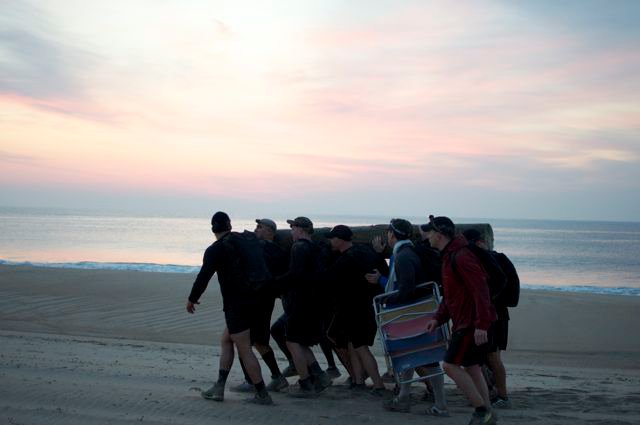
The only spot on the log that I could last for any amount of time was right at the front but once I was there, I could walk for a good distance. I would just position the log to ride on my ruck and into my neck so I could use my legs to really carry it. I spent most of the log carry either at the front staring at my feet or wincing in pain as I tried to hold the log from the side. My taller height was not cooperating.
Somewhere during our journey with the log we had to give ourselves a short rest. We all knew that if we set the log down, it was not coming back up so we stood it up vertically and had a few sips of water. Then we continued the carry until we were directed to set the log down and move on. I can’t say that I’ll miss that log one bit.
I think we then moved up the beach in more Indian sprints. Stopping at some old bunkers and snapping a few pics, spirits were still pretty high. We eventually made it up to the Cape Henlopen State Park and refilled our water before moving on down the trails. It felt great to be running on pavement, at least for me.
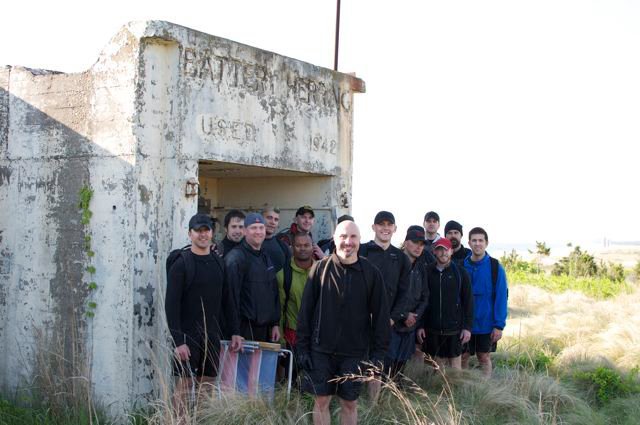
It was at this point that one of the guys was having some real trouble with his legs. Either it was cramping up or just giving out, he was suffering for a while now. We carried his ruck to lighten the load but it was still not looking good. He made the hard decision of pulling himself out. But he’s doing another one as soon as he recovers and I have immense respect for him staying as long as he did.
We were soon back on the sand, dancing along surf in our typical Indian sprint fashion. Jason saw a lone woman, walking the beach and told us to beat her to the jetty or we would be sent to the water to cool off. Well, we tried but failed, so in the water we went.
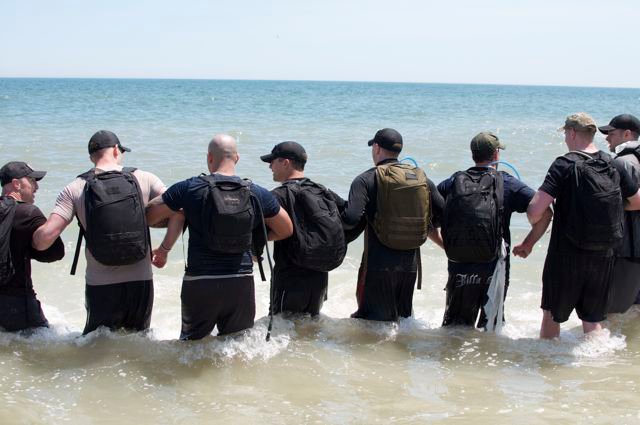
Jason decided to give us another chance although this time the stakes were higher. He found another woman walking the beach and told us to pass her before she got in line with the hotels or we would have a seriously epic Challenge. You could tell by his tone that he wasn’t joking around. We set up a system of pushing hard for 20-30 seconds followed by a shuffle to cool down. Slowly we made ground. Soon we overtook her and we were ecstatic. As we followed Jason up the beach and onto the sidewalk, we ran by what would have been our ‘prize’ for losing to the lady; a pile of seriously nasty logs. Jason even commented on how lucky we were that we beat her.
So another quick drink and snack fill up and we soon were running through the now bustling streets of Rehoboth. Getting some strange looks but feeling strong. After rounding some corners, we realized we were on the home stretch. But Jason instructed us we needed to buddy carry some guys. We got them up and I even carried 2 extra rucks to make it easier on those guys because my back was pretty much shot.
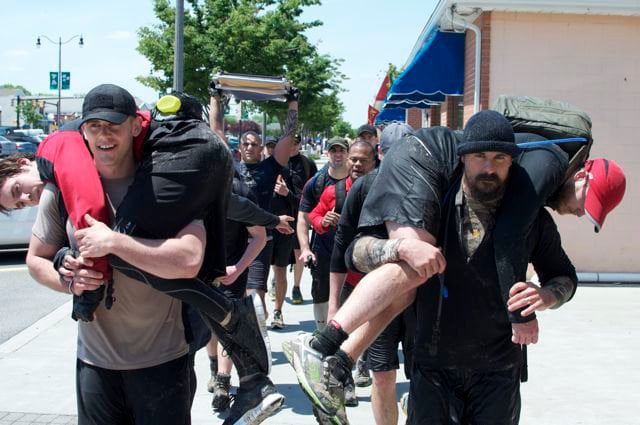
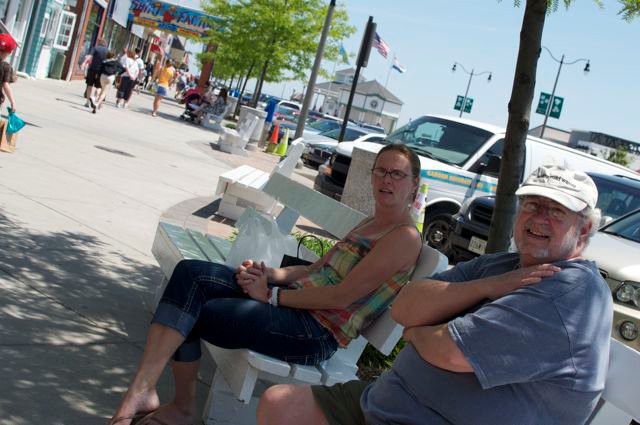
Slowly making it down the main drag and getting some very odd looks, we were within just feet of the rally point. I decided we were too quiet and needed to let Rehoboth know of our presence so I led the team in the GORUCK yell. “When I say ‘GO’ you say ‘RUCK.’ ‘GO’ ‘RUCK’ ‘GO’ ‘RUCK’ ‘GO’ ‘RUCK’ We all set foot on the band stand and cheered. After snapping a class pic, Jason gave us the good news. It wasn’t over.
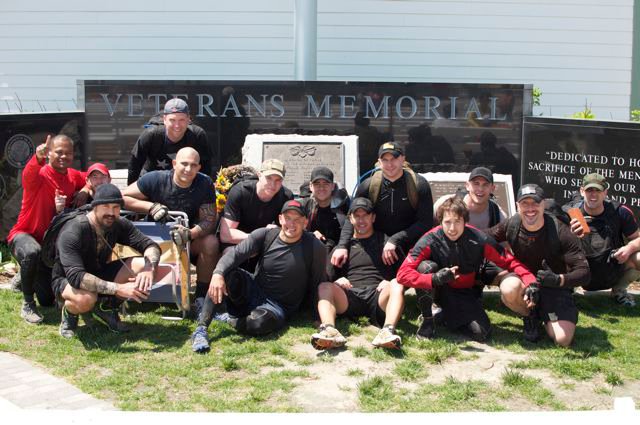
We needed a 50% carry to the surf. That meant everyone was either carrying or being carried and they all had to have their rucks on. While we just had to get to the surf, I’ll be the first to admit it seemed impossibly far away.
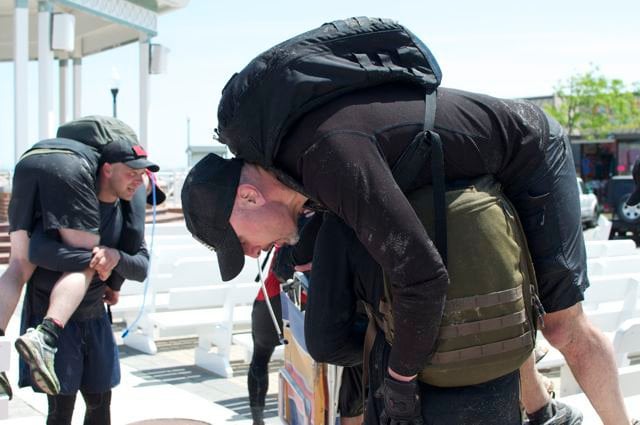
Everyone carefully but quickly got someone on their back. Ryan and I were both equally shot but I tried to get him up on me and ended up dropping him, hard. We decided the only way that would work for us was piggy back. We made it almost halfway before a few of us slipped so we stopped to reposition. Jason stated that if we stopped again, we would start the whole carry over. I told Ryan I had no more gas left and he said he could take me. I hopped up and soon we all were hobbling towards the surf. Ryan started to turn colors and his breathing sounded awful but he took step after step without faltering and made it all the way to the surf. We did it!!! We did it!!! I quickly got off and grabbed his ruck allowing him to breathe. I looked around and we were all huffing and puffing with the beachgoers either just sitting with jaws dropped or cheering. It was incredible.
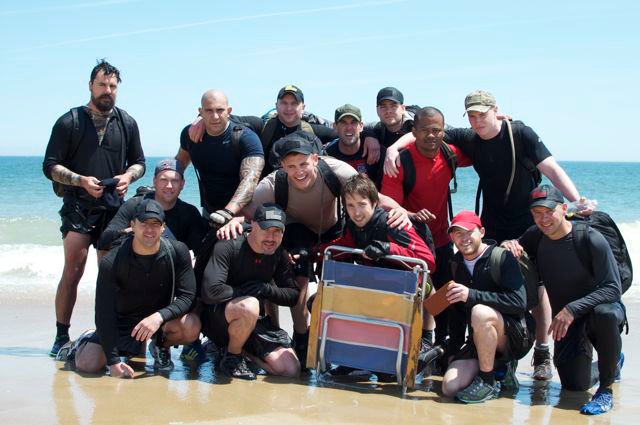
Slowly we made it back up the beach to the boardwalk. Jason congratulated us and gave us our patches. New guys first. I have never felt so alive and I am not ashamed to say I started to well up with tears. Around 17 miles and almost 13 hours later, a lot of emotions were running through me. I just did something I never thought was possible. I worked hard to capture as much about that moment as possible so I could hold onto that moment forever.
After changing my shirt and putting some fresh socks on, my new best friends and I enjoyed a nice lunch at Dogfish Head. I was in awe at how amazing my burger tasted and even more amazed I couldn’t finish my fries! I was truly exhausted. We paid our checks and parted ways. That may have been the last time we’ll ever have seen each other but I’ll never forget them. This was truly a defining moment in my life.
One of my teammates actually summed it up extremely well:
“We finished more than as we started. We finished in the sand. In the waves. Tired. Sore. Elated. Unsure if it was all really over. But more than anything, we finished as a team. Of all the times we got wet on the beach this Challenge, this last dip was a cleansing. Washing off the doubts, the flaky unsure skin we stepped up in. We left the beach in a new skin. Worn and weathered. GORUCK Tough.“
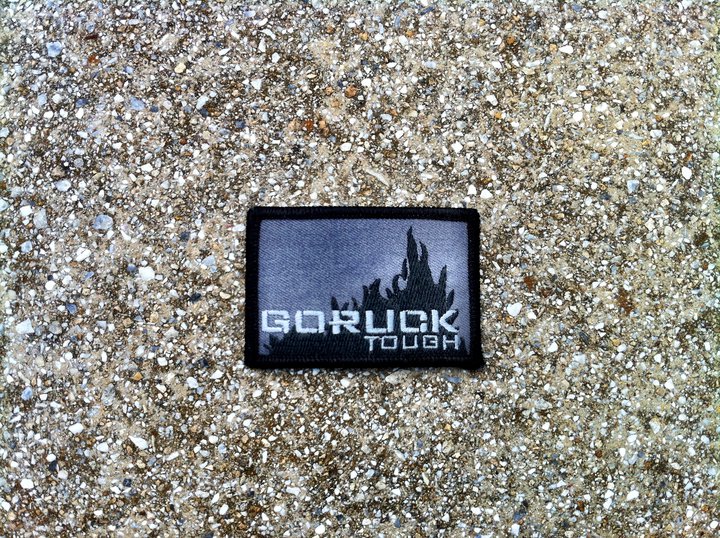
What got you through the tough moments?
My team, for one. They were right there when I needed relief on the log or to pass a coupon off. I broke each action into manageable goals. I didn’t worry about what was next because I knew that eventually, it would be over. Simple as that. I also was actually really enjoying myself. I remember a moment when I was lying on the beach, panting and soaking wet during our bounding maneuvers. Staring at my sand covered hands I thought to myself: “I should be wishing for time to pause and get a break but instead I’m thinking about how this is truly good living.”
Support
I needed a lot of support to even sign up and for that I’d like to thank Natalia Melia, Joe Gannon, Jon Gaffney and of course my always lovely and ever patient wife, Jenni. Thank you for believing in me even when I didn’t.
Under my own power, I was only able to carry someone for the first half of the final push to the surf. Thank you Ryan for transforming into a machine and taking me the rest of the way. I couldn’t have finished without you.
Lastly, I’d like to thank Jason for even making this possible. You opened my eyes to a whole new world. A world where there are no boundaries. My mind is forever set free from a prison of “can’t.” And for that, I am in your debt.
What also helped me were some quotes that I’ve come across. Read below if you care to get inspired and motivated.
- There is no terror in the bang, only in the anticipation of it.
- Pain is temporary. It may last a minute, or an hour, or a day, or a year, but eventually it will subside and something else will take its place. If you quit, however, it lasts forever.
- The final weapon is the brain. All else is supplemental.
- It is not the critic who counts; not the man who points out how the strong man stumbles, or where the doer of deeds could have done them better. The credit belongs to the man who is actually in the arena, whose face is marred by dust and sweat and blood, who strives valiantly; who errs and comes short again and again; because there is not effort without error and shortcomings; but who does actually strive to do the deed; who knows the great enthusiasm, the great devotion, who spends himself in a worthy cause, who at the best knows in the end the triumph of high achievement and who at the worst, if he fails, at least he fails while daring greatly. So that his place shall never be with those cold and timid souls who know neither victory nor defeat.
- “Whatever it is you choose to do, do it safety, but do it. Don’t be afraid to live, rather be afraid to die old and have done nothing.”
- “Why tip-toe through life to arrive safely at death?”
- You can’t volunteer to go to War and then bitch about getting shot at.
- COL Ferrando, 1st Recon BN
- In the final analysis, the soldiers pack is not so heavy a burden as a prisoner’s chains.
- Monotony is the awful reward of the careful.
- Adversity introduces us to ourselves.
- Put up with the discomfort and the pain, keep going and never give up, and understand that if you’re moving up, then you’re always getting closer.
- Familiarity breeds contempt, while rarity wins admiration.
- All men dream, but not equally, those that dream by the night in the dusty recesses of their minds, wake in the day to find that it was vanity; but the dreamers of the day are dangerous men, for they may act upon their dreams with open eyes, to make it possible.
- T. E. Lawrence, Seven Pillars of Wisdom
- Beware: strength is often hidden in absurdity.
- The Kid Who Climbed Everest
- Unless you try to do something beyond what you have already mastered, you will never grow.
- Be sure of this, that I am with you always, even unto the end of the world.
- If you live cautiously, your friends will call you wise. You just won’t move many mountains.
- Twenty years from now you will be more disappointed by the things you didn’t do than by the ones you did do. So throw off the bowlines. Sail away from the safe harbor. Catch the trade winds in your sails. Explore. Dream. Discover.
- Do everything without complaining or arguing,
- If you want something you never had, you have to do something you never did.
- Thinking Like A Mountain — Tumblr
- You’ve got to stop living for the people who’ve hurt you and the things that have happened to you, and you’ve got to start living for yourself. Do the things that make you joyful inside.
- Only those who will risk going too far can possibly find out how far one can go.
- If you have to sign a release form, it’s probably worth doing.
- The Most Interesting Man in The World
- Why do I succeed?
- I succeed because I am willing to do things you are not.
- I will fight against the odds.
- I will sacrifice.
- I am not shackled by fear, insecurity or doubt.
- I feel those emotions – drink them in and then swallow them away to the blackness of hell.
- I am motivated by accomplishment, not pride.
- Pride consumes the weak – kills their heart from within.
- If I fall – I will get up.
- If I am beaten – I will return.
- I will never stop getting better.
- I will never give up – ever.
- That is why I succeed.
- Tough Mudder Fan
- Never, never, never give up!
- We WILL fall. We CAN rise.
- Greatest Motivational Speech Ever
- Ironman — Till I Collapse
- The gates of manhood are guarded by the demons of mens souls, and those demons differ for each man. That is the test of manhood; to find what those demons are, and to slay them. That is the only way the gates can be made to open. My demon is that I’m not sure if I am the man I want to be.
- You cannot know who you are or what you are capable of until you face adversity. You cannot know the strength of the steel you hold until it strikes something solid. And you cannot know what kind of a man you are until you look hardship and difficulty in the eye, face it, and rise to it’s challenge. Without that test, you just don’t know.
- It is God who arms me with strength and makes my way perfect. He makes my feet like the feet of the deer and sets me on high places. He teaches my hands to make war, so that my arms can bend a bow of bronze. You have also given me the shield of your salvation. Your right hand has held me up. Your gentleness has made me great. You enlarged my path under me, so my feet did not slip. I have pursued my enemies and overtaken them. Neither did I turn back again until they were destroyed.
- And in this moment I will not run. it is my place to stand. We few shall carry hope. Within our bloodied hands.
- “The Hard Way” by The Art of Manliness
- I’m not quitting now. Inside me, something clicked. It no longer mattered what we did next. I didn’t care. This has got to end sometime. Deprived of support in our environment and the support of our own bodies, the only thing propping us up was our belief in accomplishing the mission–complete Hell Week. In psychology this belief is called self-efficacy. Even when the mission seems impossible, it is the strength of our belief that makes success possible. The absence of this belief guarantees failure. A strong belief in the mission fuels our ability to focus, put forth effort, and persist. Believing allows us to see the goal (complete Hell Week) and break the goal down into more manageable objectives (one evolution at a time). If the evolution is a boat race, it can be broken down into even smaller objectives such as paddling. Believing allows us to seek out strategies to accomplish the objectives, such as using the larger shoulder muscles to paddle rather than the smaller forearm muscles. Then, when the race is done, move on to the next evolution. Thinking too much about what happened and what is about to happen will wear you down. Live in the moment and take it one step at a time.
Interested in the GORUCK Challenge?
Of course you are. Go for some weighted runs, carry a log, enlist some friends and sign up. I highly recommend it. You’ll meet some extraordinary people. And remember, it’s much more of a mental battle than a physical one.
Learn more by spending time on the Challenge page and on Facebook. I’m proud to call myself GORUCK Tough and I can’t wait for you to do the same.
Further Reading on the GORUCK Challenge
Special thanks to Jason for capturing our transformation in photos. I continually look over them and relive every moment.
One More Thing
While we were only out there for half a day with Jason, I have a renewed respect for our Military’s Special Operations Community. Jason brings experience as a former Green Beret and it shows in both the manner at which he conducts himself and the authority in his voice. He is undoubtedly the guy you want to have on your team.
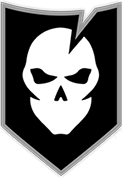





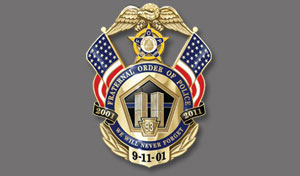 This week is the start of
This week is the start of 